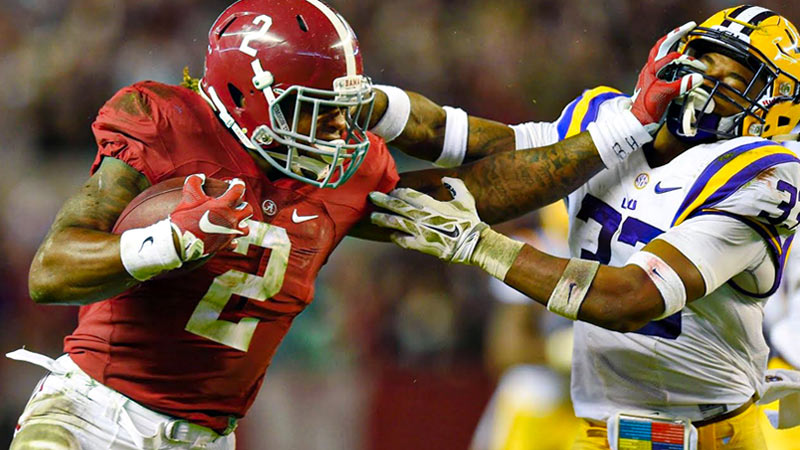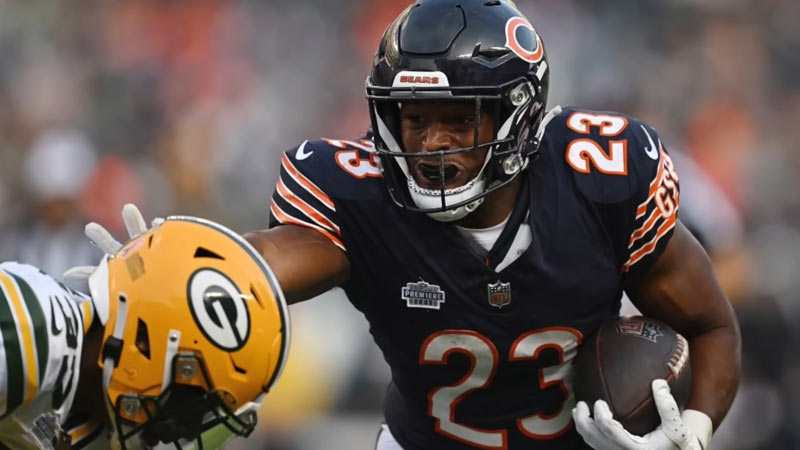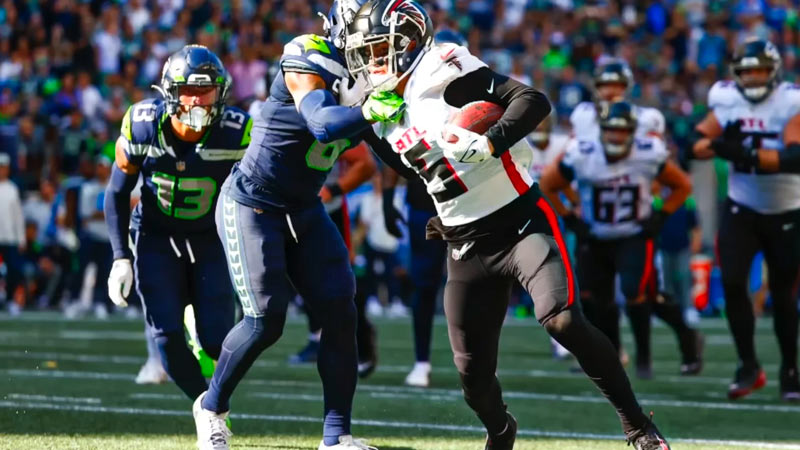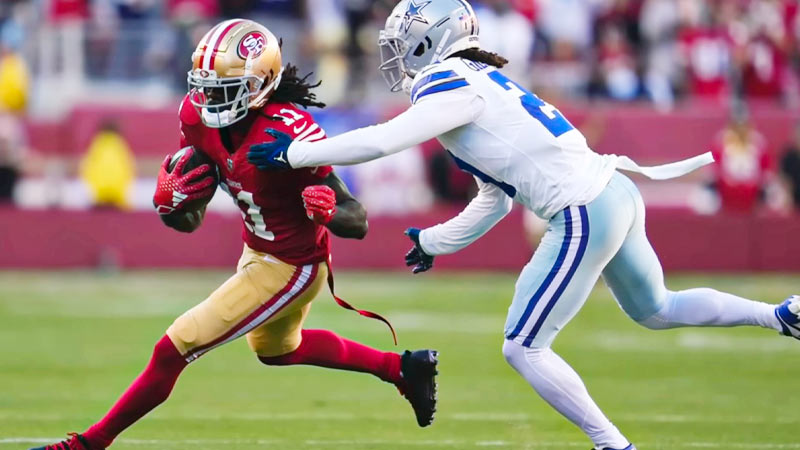In the world of American football, where speed, strength, and agility collide on the gridiron, there are various techniques employed to gain an advantage over opponents.
Additionally, defenders are constantly adapting and developing techniques to counter the stiff arm, making it a fascinating cat-and-mouse game within the sport.
One such move that often makes its way into highlight reels is the stiff arm. It’s a powerful and iconic maneuver that can change the course of a play, but can you stiff arm in football, and what are the rules governing this technique?
In this exploration, we’ll dive into the world of stiff arms in football. From its origins to the specific situations where it can be effectively employed, we’ll uncover the nuances of this skillful move.
Whether you’re a football enthusiast or just curious about the sport, join us on this journey to understand the art and legality of the stiff arm in American football.
Can You Stiff Arm in Football?
The stiff arm is a move typically employed by ball carriers, particularly running backs and wide receivers, to fend off defenders who are attempting to tackle them.
When executed, the player extends their arm, forcefully pushing against the defender’s chest or face mask to create space and maintain balance.
The effectiveness of the stiff arm lies in its ability to create distance between the ball carrier and the defender, giving the ball carrier an opportunity to continue advancing down the field.
Origins and Evolution
The stiff arm has a long history in football, dating back to the early days of the sport. It’s a technique born out of necessity, as early football lacked the protective equipment and strict tackling rules of the modern game.
Players resorted to using their arms and hands to protect themselves from oncoming defenders.
Over time, the stiff arm evolved into a more refined and strategic move. Players began to use it not only for self-preservation but also as a means to gain an advantage over defenders.
The art of the stiff arm became a central part of a ball carrier’s toolkit, with players like Jim Brown, Walter Payton, and Barry Sanders showcasing its effectiveness in memorable runs.
The Legality of the Stiff Arm

The stiff arm, when executed within the boundaries of the rules, is completely legal in football. However, there are important rules and guidelines that players must adhere to when employing this technique:
Contact Zone
The stiff arm must make contact with the defender’s chest or shoulder area. While contact with the defender’s face mask or helmet is generally prohibited, incidental contact may occur during the execution of the stiff arm without resulting in a penalty.
Avoiding Grabs and Hooks
Ball carriers must avoid grabbing or hooking the defender’s facemask, jersey, or shoulder pads while using the stiff arm. Deliberate attempts to hold or restrain the defender can result in penalties.
Defensive Reactions
Defenders have the right to attempt to tackle the ball carrier within the rules of the game. If a defender responds to a stiff arm with excessive force or an illegal tackle, they may be penalized.
Use of Open Hand
While the stiff arm is often depicted with a closed fist, it is typically executed with an open hand. A closed-fist stiff arm that makes contact with the face mask or helmet is more likely to draw a penalty.
Face Mask Penalties
Contact with the defender’s face mask, especially if it’s intentional or results in twisting the face mask, is a penalty. Face mask penalties can result in the loss of yards for the offense.
Helmet-to-Helmet Hits
Both ball carriers and defenders must avoid helmet-to-helmet hits, as they are subject to penalties and potential fines for unnecessary roughness.
It’s important to note that while the stiff arm is legal when used properly, the interpretation of these rules can vary, and officials may err on the side of caution when assessing penalties.
Players are trained to use the stiff arm in a way that minimizes the risk of penalties while maximizing its effectiveness.
How to Execute Stiff Arm Effectively?

Executing the stiff arm effectively requires a combination of physical attributes and football acumen. In essence, the art of the stiff arm is a symphony of physical might and mental finesse.
When executed masterfully, it’s not just a move; it’s a statement of dominance and a thrilling display of football skill. Let’s take a look at the key components that make this maneuver an art:
Strength and Power
At its core, the stiff arm relies on raw strength. Ball carriers need powerful arms and upper bodies to forcefully extend their arm and ward off would-be tacklers. It’s a display of physical dominance, where the stronger athlete often prevails.
Precision Timing
Timing is the secret ingredient that turns a stiff arm into a game-changing move.
The ball carrier must have an innate sense of when to unleash the stiff arm, catching the defender in a vulnerable position. It’s a split-second decision that can make all the difference between success and failure.
Balancing Act
While extending the arm, maintaining balance is paramount. If the ball carrier leans too far in one direction, they risk toppling over or veering out of bounds. A perfect stiff arm allows them to stay upright, keeping the play alive and the defenders at bay.
360-Degree Vision
Effective stiff-arm artists possess an almost supernatural awareness of the field. They need to not only focus on the immediate threat but also keep an eye on the positioning of other defenders.
This panoramic field vision enables them to make quick decisions about where to go next once they’ve fended off a tackler.
Field Geography
The best stiff-arm practitioners are like navigators on the gridiron. They have an ingrained sense of the field’s dimensions—the distance to the first-down marker, proximity to the sideline, and the precious real estate of the end zone.
This spatial awareness allows them to maximize the stiff arm’s impact, ensuring they gain those extra yards or score that crucial touchdown.
How to Get Past a Stiff Arm in Football?

Getting past a stiff arm in American football can be a daunting task, as it’s a move employed by ball carriers to fend off would-be tacklers effectively.
However, there are several techniques and strategies that defenders can employ to counter the stiff arm and make a successful tackle.
Anticipate and Prepare
The first step in countering a stiff arm is anticipation. Defenders must be mentally prepared for the possibility of a stiff arm and be ready to react quickly.
This means maintaining focus on the ball carrier’s torso and arms, as these are the areas where the stiff arm is likely to be deployed.
Stay Low
When approaching a ball carrier, defenders should maintain a low center of gravity. This lowers the target for the stiff arm and makes it more challenging for the offensive player to effectively extend their arm and create separation.
Leverage and Technique
Proper tackling technique is crucial when facing a stiff arm. Defenders should aim to make contact with the ball carrier’s legs or lower body, rather than trying to engage with the upper body.
By targeting the legs, defenders can effectively negate the stiff arm and bring the ball carrier down to the ground.
Swiping Motion
Defenders can use a swiping motion with their arms to knock down the ball carrier’s stiff arm.
As the ball carrier extends their arm, the defender can quickly swipe down on the offensive player’s forearm, disrupting their balance and reducing the effectiveness of the stiff arm.
Pursuit Angle
Angle of pursuit is vital when tackling a player using a stiff arm. Defenders should aim to approach the ball carrier at an angle, rather than head-on. This angle allows them to attack the extended arm or the ball carrier’s lower body more effectively.
Team Effort
In many cases, stopping a player with a stiff arm is a team effort. Multiple defenders can converge on the ball carrier from different angles, making it difficult for them to use the stiff arm effectively.
Teamwork and communication are key to preventing the ball carrier from gaining extra yardage.
Wrap Up
Once a defender gets in close proximity to the ball carrier, it’s essential to wrap up and secure the tackle. This means using proper form and technique to grab the ball carrier and prevent them from breaking free.
Even if the stiff arm is initially deployed, wrapping up can neutralize its impact.
Learn from Film
Studying game film can provide valuable insights into the tendencies of specific ball carriers. Defenders can identify when and how a particular player likes to use the stiff arm, enabling them to prepare and react accordingly during a game.
Finally, adaptability is key. The ability to adjust one’s approach based on the specific circumstances of a play is critical in countering the stiff arm. Defenders must be agile in their thinking and willing to try different techniques to succeed.
FAQs
Is the stiff arm always legal in football?
No, the stiff arm is not always legal. To be legal, the stiff arm must make contact with the defender’s chest or shoulder area. Contact with the defender’s face mask or helmet is generally prohibited.
What are some common mistakes ball carriers make when using the stiff arm?
Common mistakes when using the stiff arm include making contact with the defender’s face mask, grabbing or holding the defender’s jersey, and using excessive force that leads to penalties.
Can defenders use the stiff arm against ball carriers?
Yes, defenders can use the stiff arm against ball carriers to fend off blockers or create separation. However, defenders must also adhere to the same rules regarding legal contact.
Are there any famous stiff-arm moments in football history?
Yes, there have been numerous famous stiff-arm moments in football history. One of the most iconic stiff arms in NFL history occurred when Cleveland Browns running back Jim Brown stiff-armed a defender during a 1964 game against the Washington Football Team.
How can defenders train to counter the stiff arm effectively?
Defenders can train to counter the stiff arm effectively by working on their tackling techniques, pursuit angles, and leverage. They can also practice specific drills that simulate situations where they need to engage with ball carriers using the stiff arm.
Conclusion
The stiff arm remains a captivating and impactful technique in American football, offering players a means to gain an advantage over defenders and extend their plays.
While its use is legal and celebrated within the confines of the game, mastering the stiff arm requires a combination of physical prowess, timing, and field awareness.
As we’ve explored, the stiff arm allows ball carriers to fend off would-be tacklers by using their arms to create distance and leverage. When executed effectively, it can lead to exhilarating moments on the field.
However, the stiff arm isn’t without its limitations and potential pitfalls. It must be used within the boundaries of the rules, avoiding illegal contact to the face mask or helmet.
The stiff arm is a testament to the athleticism, creativity, and strategy that define American football. It’s a reminder that, in this dynamic and physically demanding sport, players must utilize a wide array of skills to excel and leave their mark on the game.







